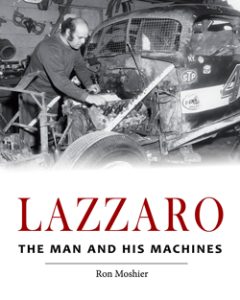BALLSTON SPA, N.Y. — Down through the years, we’ve known hundreds of racers who were convinced they had less money than the top drivers and could be a big winner too if only a big sponsor or two would sign on to put them on an equal footing with others.
At the same time, we have always known from personal observation that New York modified star Lou Lazzaro really was poor and won races on both dirt and asphalt by the handful in a rust-bucket ’36 Pontiac coupe on the strength of incomparable talent.
These observations were reinforced recently when publisher Lew Boyd’s Coastal 181 released, “LAZZARO: The Man and His Machines” by longtime Utica Observer-Dispatch sportswriter Ron Moshier.
Moshier grew up in a family of race fans and as a youth was a big fan of Lazzaro’s archrival, “Fightin’” Kenny Shoemaker. But by the time he graduated from college and embarked on a four-decade sports writing career in the Mohawk Valley, he had come to appreciate what the burly Utican known to fans as “The Monk” due to his balding pate and to racing insiders simply as “Louie” was accomplishing on less than a shoestring budget.

The rest, as they say, is history. Moshier has put together a great read through a combination of personal notes and news stories, quotes from articles by other writers and extensive interviews with family members and others who knew Lazzaro “up close and personal.”
The 160-page book tracks Lazzaro from his youth in a tough East Utica neighborhood to his early days racing with lifetime supporters Vinnie Maugeri and Pete “Junior” Bianco and on to his winning years in his trusty fuel injected big block NASCAR modified.
During his salad days, he garnered wins at his favorite track, the venerable half-mile dirt Fonda Speedway, by the handful, running the extreme outside most of the time while also being able to drive under those who moved up to block him.
When he had the crowd booing him for winning too often, management made the features 50 laps and he still won. So they went to Twin 25s, with Louie handicapped to a starting position deep in the pack. He still won more than his share, often snaring both halves of the feature, and he even joked that four “twelve and a halfs” would be next.
Moshier relates not only the accomplishments of his city’s most accomplished driver but also his lifelong financial struggles. Lazzaro supported his large family by racing for many years, at the same time making a minimal investment in his racer. Had it not been for a long list of friends, fans and supporters, one of America’s most talented short-trackers would have been just another racer who ran out of money, disappeared from the sport forever and lived out his days in poverty.
Instead, Lazzaro notched a handful of track championships, some 251 wins overall and was the only two-time champion of the hard-fought All-Star League, snaring titles in 1968 and 1971.
But Fonda was his place and even when he was recovering from serious health problems and running outdated equipment, he made the trek down the New York State Thruway to the odd-shaped fairgrounds oval every Saturday night and even managed to add a win or two to his career total at an age when other competitors his age were long retired.
Moshier, a great interviewer and stickler for detail, ends the book as readers know he must, describing in great detail the night Louie was stricken while on the track that was his home away from home. His legion of admirers were bereft but somewhat comforted by the fact that he spent his last hours on the track where he’d notched 113 wins, countless podium finishes and entertained multiple generations of fans.
Northeastern fans all knew Lazzaro and will love the book but readers who never saw him race will also appreciate his travels from the fifth-mile Bennet’s Field Speedway in his hometown to Daytona Int’l Speedway and countless tracks and races in between, generally in a rag tag tow car that most people would never leave home in.
In the interest of full disclosure, we provided both background material and a number of quotes for the book, in the process gaining even more respect for Moshier as an author. Hopefully, this won’t be his last racing book.
“LAZZARO: The Man And His Machines” is available from Coastal 181 at www.coastal181.com.
